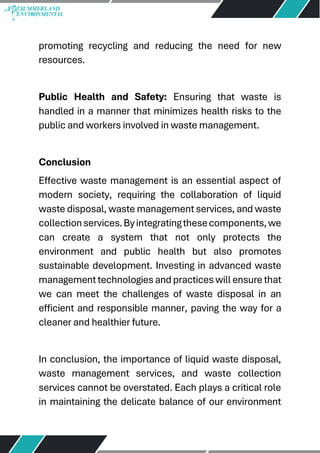The Buzz on Reclaim Waste
The Buzz on Reclaim Waste
Blog Article
Getting My Reclaim Waste To Work
Table of Contents10 Simple Techniques For Reclaim WasteReclaim Waste Can Be Fun For EveryoneFacts About Reclaim Waste RevealedTop Guidelines Of Reclaim WasteAll About Reclaim Waste
Residential sewer waste refers to the waste and items from a household septic tank. The proper monitoring and disposal of residential sewage waste require fluid waste to be moved to a sewage treatment plant where the correct methods and equipment are applied to purify and dispose of waste.
Commercial waste commonly includes prospective dangers, such as flammable products or a mixture of fluid and solid waste items, and calls for a more sophisticated and in-depth disposal procedure. The disposal of industrial waste commonly entails the filtration of waste prior to transport to make sure secure and appropriate disposal. Hazardous waste is created from by-products and runoff of industrial procedures and manufacturing.
This type of waste can not make use of the exact same sewage administration transportation or procedures as septic or industrial fluids. The hazardous waste administration procedure requires the inspection and testing of fluid waste prior to it undertakes the disposal procedure (liquid waste disposal). Drainage waste is the fluid waste that comes from overflow and excess stormwater in very inhabited areas or cities
Overflow waste can create contamination and flooding if not dealt with effectively. Find out more concerning sewer cleansing and waste monitoring. Guaranteeing correct waste monitoring can avoid catastrophes and reduce environmental harm. Both individuals in residential settings and professionals in business or manufacturing industries can gain from recognizing the processes and regulations of fluid waste management.
Some Of Reclaim Waste
Contact PROS Providers today to find out about our waste monitoring and disposal services and the correct ways to look after the fluid waste you produce.
(http://peterjackson.mee.nu/where_i_work#c2441)This supposed 'wastewater' is not only a crucial resource but, after therapy, will be launched to our land, rivers or the sea. Made use of water from toilets, showers, bathrooms, kitchen sinks, washings and commercial processes is known as wastewater.

water used to cool down equipment or tidy plant and devices). Stormwater, a kind of wastewater, is runoff that streams from farming and urban areas such as roofing systems, parks, gardens, roads, paths and rain gutters into stormwater drains, after rainfall. Stormwater flows without treatment straight to local creeks or rivers, ultimately reaching the sea.
The Buzz on Reclaim Waste
In Queensland, many wastewater is treated at sewer treatment plants. Wastewater is delivered from domestic or commercial sites through a system of drains and pump stations, called sewage reticulation, to a sewer therapy plant. Neighborhood governments build, maintain and operate most sewage treatment plants. Operators are licensed under the Environmental Management Act 1994 to discharge cured wastewater at an acceptable environmental criterion right into waterways.
The Division of Natural Resources recommends regional governments about handling, operating and maintaining sewerage systems and treatment plants. In unsewered locations, city governments may need owners to mount private or family sewer treatment systems to treat residential wastewater from commodes, kitchens, shower rooms and washings. The Department of Natural Resources authorizes making use of family systems when they are verified to be effective.
Most stormwater obtains no treatment. In some new subdivisions, therapy of some stormwater to get rid of clutter, sand and crushed rock has actually begun using gross contaminant catches. Wastewater treatment happens in 4 phases: Eliminates strong issue. Larger solids, such as plastics and other objects wrongly discharged to drains, are gotten rid of when wastewater is passed via displays.
Wastewater after that moves right into huge storage tanks where solids work out and are removed as sludge. Oil and residue are skimmed from the surface area. Utilizes little living microorganisms referred to have a peek at this website as micro-organisms to damage down and eliminate continuing to be dissolved wastes and great fragments. Micro-organisms and wastes are included in the sludge. Eliminates nitrogen and phosphorus nutrients that might create algal blooms in our waterways and endanger water life.
Top Guidelines Of Reclaim Waste
Nutrient removal is not offered in any way sewage treatment plants due to the fact that it calls for costly specialist tools. It is coming to be more common in Queensland. Clear fluid effluent produced after therapy might still contain disease-causing micro-organisms. If this effluent is released right into rivers such as rivers or the sea, the micro-organisms will eventually pass away out.

This generally suggests wastewater needs to be treated or contaminants eliminated before it can be released to rivers. A lot of wastewater streams into the sewerage system. Under the Act, local governments carry out approvals and permits for ecologically appropriate tasks (Ages) including wastewater releases that could have a regional influence. The division administers authorizations and permits to Periods involving wastewater releases that might have a local or statewide effect.
The 10-Second Trick For Reclaim Waste
Monitoring gives accurate info about water high quality and can verify that licence problems are being met. The information obtained with surveillance provides the basis for making water quality decisions.
Report this page